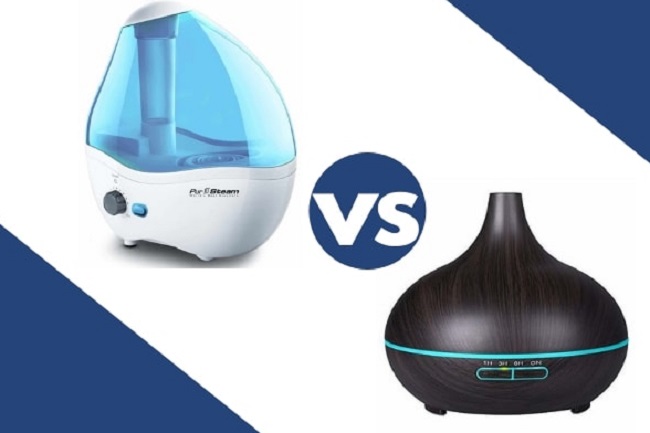A diffuser is a device that emits scented oil-based mist within a room. A humidifier is designed to inject water vapor into the air, helping you breathe easier and remain healthy during dry winter months or hot summer days. Though both emit scents, these devices work in different ways, have specific uses, and have potential side effects.
Differences between diffuser and humidifier
Diffusers stand out from humidifiers in that they emit scented oil particles into the air. They do not add to the humidity of a space. While diffusers can be used during dry winter months, they are especially useful for putting essential oils into the air during hot summer months when it’s best to avoid adding water to the environment.
Usage
Diffusers, unlike humidifiers, are used to put essential oil scents into the air. Humidifiers operate by adding moisture back into dry rooms via evaporating water with a fan. They can help improve your respiratory function during cold months when the heat is running and the indoor environment becomes increasingly dry.
Side effects
Diffusers should not cause headaches or other side effects. However, if you notice your diffuser is emitting too much oil into the air, you may want to change the way you use it. If your diffuser starts to make a gurgling sound, turn off the unit and let it rest for three to four hours before using it again. If the noise does not stop or you notice discolored water, it’s time to get a new diffuser.
Humidifiers can cause headaches and nosebleeds if they are used incorrectly. Be sure to keep the tank full of water, so your humidifier doesn’t emit scented oil into the air without much humidity. Also, clean the humidifier often to prevent bacteria and mold from growing in the water tank. The best humidifier for baby keeps you away from these.
Performance
Though both emit scents into the air, adding humidity to a space is not the diffusers’ primary function. Most humidifiers have a built-in humidistat that shuts off when the desired humidity level is reached. Diffusers work continuously until shut off manually.
Types
There are many types of diffusers that vary in design, mechanism and cost. Ultrasonic units are the most popular because they emit mist quietly using metal rods and ultrasonic vibration. Other types include heat, fan, nebulizing and evaporative diffusion, to name a few.
Purpose
Humidifiers and diffusers serve different purposes. While humidifiers give an immediate boost to humidity levels, diffusers are meant for masking scents or to keep the air fresh.
Cost
Diffusers vary widely in price based on your needs. You can buy a simple, compact diffuser with a small tank for around $25 USD. There are also larger units with bigger tanks and more features. If you have severe allergies or respiratory problems, consider investing in a more expensive model that has humidity control and an ionizer.
Diffusers range from about $15 to $20 USD. Humidifiers can cost anywhere from $20 to upwards of $500 for ultrasonic models with built-in humidistat controls.
Which is safe for the baby?
Both types of devices have been deemed safe to use around children. Ultrasonic diffusers are a great alternative for children’s rooms because they emit less heat than heat diffusers do. Humidifiers, when used correctly, can also help ease breathing in infants and young children. If you want to know more, go through the Pro baby guide.
Conclusion
Diffusers are mainly used to emit essential oils into the air, which they do without adding humidity. Some diffusers have automatic shut-off features, while others must be turned off manually when they run out of water. If you want to add humidity to a room, use a humidifier. Although both devices emit scents and moisture into the air, they each have specific functions and should not be used interchangeably.

